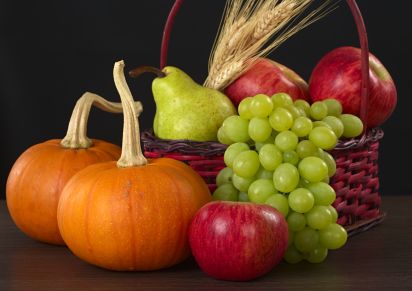What are Carbohydrates?

What are Carbohydrates?
Carbohydrates are organic compounds that can be divided into three groups—sugars, starches and fibers. When discussing carbs in terms of your health we usually divide them into two groups - simple carbohydrates and complex carbohydrates.
What are carbohydrates - Simple ones have a simple design.
Simple carbohydrates are the sugars that occur naturally in foods, along with the sugars that we add to foods. They are called "simple" because they have a very simple chemical structure that is easily broken down by the digestive system.
Simple carbs tend to get into your bloodstream very quickly to give you energy.
Here is a list of some simple carbohydrate foods:
-Table sugar
-Honey
-Molasses
-Syrups
-Soft Drinks
-Fruit Juice
-Candy
Interesting Fact for What are Carbohydrates: Although white flour is technically a "starch," and not a sugar, refinement causes it to become more like a simple sugar, since it is easily broken down into glucose in your body. This means that when you eat white bread and other products made from white flour, it is more like eating sugar than starch.
Complex ones are more complicated
Complex carbohydrates are the starches and fibers. Starches are stored by the plants that we eat, and so, come almost exclusively from plant foods. Fibers make up the structures of plants and are classified as soluble fiber and insoluble fiber. Both types of fiber are essential to a healthy eating lifestyle. Complex carbs have a more complicated chemical structure and are more difficult for your body to digest. Some, such as fibers, are not digested at all.

Here is a list of some foods with complex carbohydrates:
-Vegetables
-Whole Fruits
-Whole Grains
-Beans
-Lentils
-Split peas
-Cashews
Glycemic Index
You may have heard of called the Glycemic Index. This is a way of measuring how fast the sugar from carbohydrates will be absorbed into your bloodstream. This issue may be important with regard to weight loss and control of Type II Diabetes, because of its affect on insulin, the hormone produced by your pancreas that allows the glucose to enter the cells and provide energy. Generally, the simpler the carbohydrate, the more swiftly it is broken down and shows up as glucose in your blood.
Click here for more information on the Glycemic Index.
Are they bad for you?
Carbohydrates have gotten a bad reputation in recent years, but, it is safe to say that without them, you will not feel well. It is important for you to know that you can be healthy (and maintain a desirable weight) eating carbohydrates. In fact, you need them for energy, and they also contain many of the other nutrients, such as vitamins, minerals and fiber that your body needs.
What are carbohydrates?
Carbohydrate foods are the plant foods that you eat. There are the healthy carbs, such as
Foods from whole grains: Breads… Rolls… Pasta… Cereal… Bagels… Rice…
Fruits: Apples… Oranges… Pears… Bananas… Grapes… Berries… Peaches… Watermelon… Pineapple… Kiwi… Grapefruit…
Vegetables: Lettuce… Broccoli… Carrots… Potatoes… Peas… Corn… Onions… Beans… Spinach… Squash…
and there are less healthy (some would say un-healthy) choices, such as
French fries… Doughnuts… Chips… Pies… Cakes… Cookies… Products made from all white flour.
It is important that you choose most of your foods from the first list rather than from the second. In addition to being poor carb foods, the foods in the second list are generally loaded with fat, particularly saturated fat and trans-fats, which have been implicated as bad actors in the rise of heart disease and cancer.
Starchy vs. Non-starchy Vegetables
Within the vegetable group, there is a difference between those with a significant amount of carbohydrates, and those with not much carbs at all.
Starchy vegetables: Carrots, Potatoes, Winter Squash, Corn, Peas, and Sweet Potatoes
Less-starchy vegetables: Broccoli, Lettuce, Spinach, Green Beans, Peppers, and Summer Squash
Although both of these groups offer healthy nutrition, if you are trying to lose weight, choose vegetables from the less starchy group more often than from the starchy group.
Protein, too
Certain plant foods that are mostly carbohydrate foods, will also supply a significant amount of protein.
Lentils… Split peas… Kidney beans… Pinto beans… Black beans… Soybeans… Garbanzo beans… Navy beans… Peanuts… Peanut Butter… Rice… Wheat…. Barley… Oats… Peas…
When you eat these foods, you are getting the advantages of both a good source of carbohydrates as well as a significant source of protein. Many of them have the added advantage of being high in fiber.
Animal foods
Dairy products are the one category of animal products that supply significant carbohydrate. Lactose is milk sugar and is found in milk, yogurt, cheese and ice cream.
There also is some carbohydrate found in liver, but it is not considered a significant source.
What is a serving?
The serving size for carbohydrates varies according to type. For the Bread, Cereal, Rice and Pasta Group, a serving would be 1 slice of bread, ½ cup cooked pasta, rice or cereal, 1 small roll, biscuit or muffin, ½ bagel or bun or 3 small crackers.
For vegetables, a serving would be ½ cup cooked or raw or 1 cup leafy greens and for fruits, a serving would be 1 medium for most fruits, 1 melon slice, ½ grapefruit or ½ c. berries or canned fruit. A serving of vegetable or fruit juice is ¾ cup.
What to remember
Include a variety of carbohydrate foods in your diet. Emphasize whole grains and colorful fruits and vegetables. Pay attention to portions, especially of the starchy carbs, if you are watching your weight. Learn to differentiate between good carbs and bad carbs.
Click here for a list of Good Carbs.

